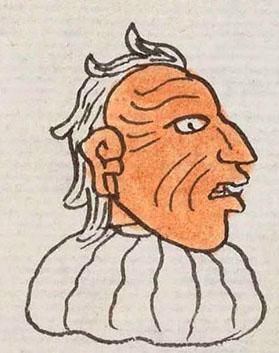Xolochiuhyan (Mdz38r)
This simplex glyph of the place name Xolochiuhyan shows an old man with wispy gray hair and a very wrinkled face. He is shown in profile, facing to the viewer's right. His mouth is slightly open, and only a few teeth are visible, as though he has lost most of them in his older age. He is wearing a white shirt with vertical stripes. The -yan (locative suffix) is not presented visually.
Stephanie Wood
This simplex glyph of the place name provides a graphic syllepsis in that one can read simply xolo (page, servant, or enslaved person), or xolochtic (wrinkled), and/or the combining stem of the verb chihua ("chiuh"). The root xolo can also refer to the ancestral leader/deity Xolotl, who is often shown with a wrinkled face, too.
According to Frances Karttunen, the locative suffix -yan is one that attaches to verbs and indicates customary action. [Frances Karttunen, unpublished manuscript, quoted here with her permission.] In this case, the verb would be chihua (to make, to do). Perhaps this is a place where people get wrinkled (or live to an old age). Berdan and Anawalt wondered whether perhaps enslaved persons were made in this place, given that xolo could refer to a page, a servant, or a slave.
Stephanie Wood
c. 1541, but by 1553 at the latest
Stephanie Wood
aging, wrinkles, old man, Xolotl, viejo, arrugado, envejecimiento, nombres de lugares

xolo, page, servant, or enslaved person, https://nahuatl.wired-humanities.org/content/xolo
xoloch(tic), wrinkled, https://nahuatl.wired-humanities.org/content/xolochtic
chihua, to do or make, https://nahuatl.wired-humanities.org/content/chihua
-yan (locative suffix), https://nahuatl.wired-humanities.org/content/yan
Codex Mendoza, folio 38 recto, https://digital.bodleian.ox.ac.uk/objects/2fea788e-2aa2-4f08-b6d9-648c00..., image 86 of 188.
The Bodleian Libraries, University of Oxford, hold the original manuscript, the MS. Arch. Selden. A. 1. This image is published here under the UK Creative Commons, “Attribution-NonCommercial-ShareAlike 3.0 License” (CC-BY-NC-SA 3.0).


